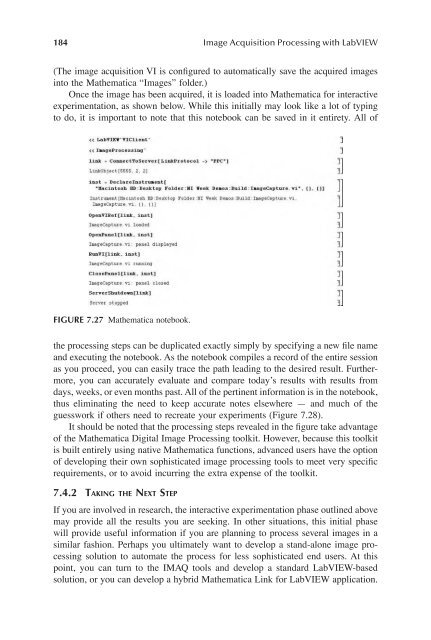Image Acquisitionand Proces
You also want an ePaper? Increase the reach of your titles
YUMPU automatically turns print PDFs into web optimized ePapers that Google loves.
184 <strong>Image</strong> Acquisition <strong>Proces</strong>sing with LabVIEW<br />
(The image acquisition VI is conÞgured to automatically save the acquired images<br />
into the Mathematica “<strong>Image</strong>s” folder.)<br />
Once the image has been acquired, it is loaded into Mathematica for interactive<br />
experimentation, as shown below. While this initially may look like a lot of typing<br />
to do, it is important to note that this notebook can be saved in it entirety. All of<br />
FIGURE 7.27 Mathematica notebook.<br />
the processing steps can be duplicated exactly simply by specifying a new Þle name<br />
and executing the notebook. As the notebook compiles a record of the entire session<br />
as you proceed, you can easily trace the path leading to the desired result. Furthermore,<br />
you can accurately evaluate and compare today’s results with results from<br />
days, weeks, or even months past. All of the pertinent information is in the notebook,<br />
thus eliminating the need to keep accurate notes elsewhere — and much of the<br />
guesswork if others need to recreate your experiments (Figure 7.28).<br />
It should be noted that the processing steps revealed in the Þgure take advantage<br />
of the Mathematica Digital <strong>Image</strong> <strong>Proces</strong>sing toolkit. However, because this toolkit<br />
is built entirely using native Mathematica functions, advanced users have the option<br />
of developing their own sophisticated image processing tools to meet very speciÞc<br />
requirements, or to avoid incurring the extra expense of the toolkit.<br />
7.4.2 TAKING THE NEXT STEP<br />
If you are involved in research, the interactive experimentation phase outlined above<br />
may provide all the results you are seeking. In other situations, this initial phase<br />
will provide useful information if you are planning to process several images in a<br />
similar fashion. Perhaps you ultimately want to develop a stand-alone image processing<br />
solution to automate the process for less sophisticated end users. At this<br />
point, you can turn to the IMAQ tools and develop a standard LabVIEW-based<br />
solution, or you can develop a hybrid Mathematica Link for LabVIEW application.



